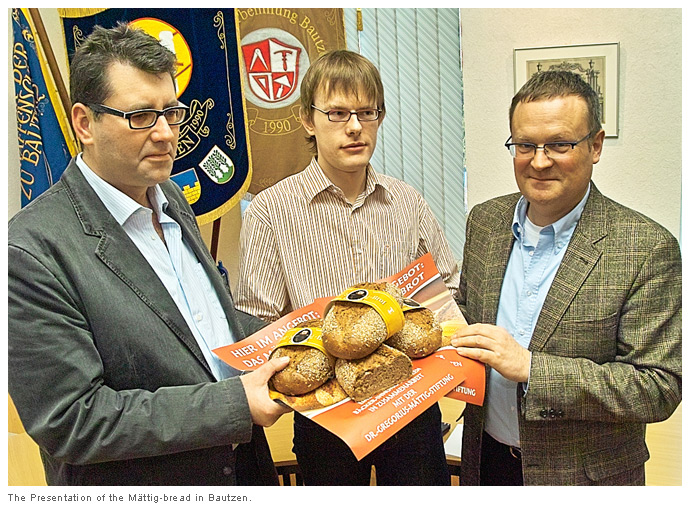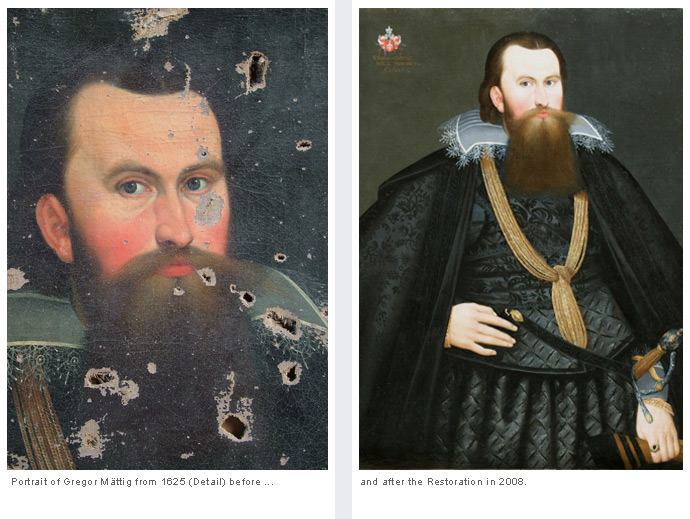 |
 |
 |
Support
The impetus for the recreation of the Foundation was given by several descendants of Gregorius Mättig,
most of whom now live in different parts of the world. However, the Foundation has to be considered
as a civil institution whose roots should be firmly ingrained in Bautzen.
Even at the beginning stages of this Foundation, we count the the district Sparkasse Bank of Bautzen and
the Lutheran-Evangelical Church among our sponsors.
But the people of Bautzen have also already made donations.
Among those, we should like to mention the following:
Ingeborg Eule, Bautzen
Regine Gebhardt, Bautzen/Soest
Dr. Wolfgang Frenzel, Crostau
Herrmann Graf Pückler, München
Robin Hermans, Sao Paulo
Dr. Dietmar Wappler, Bautzen
Dr. & Mrs. Matthias Linke, Doberschau
Donations, in addition to the initial founding capital, are of course very welcome,
as well as donations targetting a specific project. Those who would like to donate
to the Foundation can do so on the following bank account:
Dr.-Gregorius-Mättig-Stiftung
Kreissparkasse Bautzen
Account number: 10000 35820
Sort code: 855 500 00
International Account number / IBAN: DE09 8555 0000 1000 0358 20
International Bank identification code / BIC: SOLADES1BAT
Bautzen's baker guild creates Mättig bread
Mr Stefan Richter, a master baker from Kubschütz near Bautzen, has taken the initiative
to create a special bread which will bear the name „Mättig bread“.
This idea was developed in close consultation with our Foundation and represents the
first long-term partnership between regional medium-sized businesses and the Mättig Foundation.
Through this initiative with the bakers' guild of Bautzen, the aims of the
Mättig Foundation should be supported and given wider knowledge. So far, 10 bakers
from Bautzen and its surroundings have taken part in this project.
Every purchaser of the bread helps the Foundation's educational and cultural projects
by contributing 30 Eurocent.
From January 2009 onwards, the Mättig bread will be available for purchase in Bautzen,
Hochkirch, Wilthen and Kubschütz.

Restoration of the Gregorius Mättig portrait
The Dr. Gregorius-Mättig-Foundation has set itself particular objectives, amongst which
prominently feature the preservation and the development of Mättig's legacy.
A street in Bautzen carries his name, his epitaph and the two chandeliers in the
cathedral conserve his memory and in the city museum's permanent collection, one
could admire his painted portrait and a tomb slab from 1650.
But his legacy is far greater: witness the following important painting from 1626,
which was severely damaged in the Second World War and which was kept in the Museum's
storage rooms until recently.
Thanks to the collection raised during the festive Church service, as well as further
contributions and aid from the Sparkassen Bank Foundation for the county of Bautzen,
this painting was fully restored to its former glory in 2008 on behalf of the City
and Regional Museum of Bautzen.
The following is a short note on the restoration process,
its difficulties and its complexity:
The obvious signs of damage, countless large and smaller holes in the
entire canvas and even in the wooden frame, are a legacy of the Second World War.
The canvas and the wooden frame showed up traces of small shell splinters, which may
originate from an explosion during the last few weeks of bitter fighting around Bautzen.
Yet the painting had already been restored once before.
The original tenter frame was removed, the picture was relined onto a second canvas
and mounted onto a slightly smaller stretcher frame.
By doing so, a few centimetres of canvas on all edges were lost. Unfortunately, the picture
was also cut at the bottom, so that the left hand was clipped.
As the picture had not been stretched for a long time, the canvas was able to work,
thereby allowing the colour coat to mount in certain areas.
The varnish had turned yellow through old age and certain regions showed up darkened
retouchings from the aforementioned restoration. The shock of the explosion caused
the impact of miniscule grains of sand, thereby allowing the bursting out of
hundreds of small particles of pigment and varnish.
The surface was covered with a sticky layer of dirt.
The restoration began by tightening the loosened colour coat with hide glue.
Warming and consequent pressing levelled the bulging colour coat areas out.
The surface was damp cleaned. The varnish was taken off with isopropanol
and the darkened retouchings were eliminated with dimethyl formamide. The relined canvas
was slowly removed after the glue had started to swell. The holes were filled with
specially cut-out pieces of canvas cloth.
After having smoothened the entire painting through cold pressing, the picture was
relined once more under vacuum by applying a hot seal adhesive. The fragmented stretcher
frame was reconstituted and stuck together with fish glue.
To increase the stability of the frame, a few wooden pieces were introduced. Moreover,
the size at the bottom of the frame was increased by 2,5 cm.
The imperfections in the colour coat were filled in with a greyish chalk glue, smoothened
and structured according to the environment. The defects were then retouched with
dry pigments and a reversible, non-yellowing synthetic resin. Finally,
the painting was coated with a synthetic varnish with only a limited
amount of beeswax.

Portrait of Gregor Mättig
1626 ...
oil on canvas
H.= 98,5 cm; B.= 86 cm (without frame)
Inv.-Nr.: R 2561 (Collection Oskar Roesger; came to the museum between 1868 and 1910)
About the artist
We have no firm dates of birth or death concerning the artist Adam Lämmel. It can be established that he lived in
Bautzen from 1617 to 1636 and that he obtained several commissions from the Council. In 1617, Adam Lämmel received
payment for two portraits of the city mayor,
A. Böhmer. A few other portraits are attributed to him and are presently
part of the collection of paintings depicting mayors at the City Museum in Bautzen.
Description
Due to the abundance of bullet impacts, blemishes in the layer of paint and the covering layer of surface grime,
it is at present only possible to give a very limited description. This means that any details will only resurface
after full restoration. A black and white photograph which dates
from the time previous to the destruction of the
painting, shows Mättig in almost the same clothing as on the Mättig portrait of 1650 (see Peucer catalogue P. 194).
We can already say that this painting is in no way inferior in quality to the later one of 1650. Presumably, it
is a representative portrait: notable are the more detailed and accurate rendering of the clothing, illustrated
by the tapered trimmings of the collar; by the workmanship of the jewellery, present on both wrists and the
heavy golden chain laid out over the torso. The jacket and gown are made of silk damask, which refers to the
fashion of the squires. The dagger, the gauntlet glove and the loosely knotted decorative shawl complement
the clothing. In addition, there is the combed back shoulder length hair and the broad, square shaped beard.
In spite of the damage to the painting, we can clearly make out a valuable ring. At the top of the painting,
on the left, appears his coat of arms: a silver lily on a red background.
Total cost of restoration:
EUR 13,000.
Source: expert Ophelia Rehor, Bautzen City Museum. |
 |
 |
|
 |

